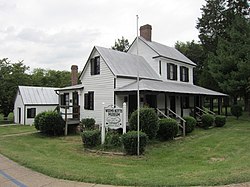Weems–Botts Museum
|
Weems–Botts House
|
|

Weems-Botts House
|
|
| Location | Corner of Duke Street and Cameron Street Dumfries, Virginia |
|---|---|
| Coordinates | 38°34′07″N 77°19′49″W / 38.56861°N 77.33028°WCoordinates: 38°34′07″N 77°19′49″W / 38.56861°N 77.33028°W |
| Area | 1.6 acres (0.65 ha) |
| NRHP Reference # | 75002029 |
| VLR # | 212-0010 |
| Significant dates | |
| Added to NRHP | May 12, 1975 |
| Designated VLR | April 15, 1975 |
Weems–Botts House Museum is a small historic museum in Dumfries, Virginia, United States. The museum includes the landmark Weems–Botts House on the corner of Duke Street and Cameron Street and the Weems–Botts Museum Annex on 3944 Cameron Street. The museum shows the history of Dumfries, Virginia's oldest chartered town, and two people who lived in the house: Mason Locke "Parson" Weems, and attorney Benjamin Botts.
The house originally served as the vestry for the Quantico Church. The museum was restored by Historic Dumfries, Inc. in 1975 as part of a bicentennial U.S. restoration project. A gazebo was also built during the bicentennial to commemorate William Grayson, one of Prince William County's most respected citizens.
Parson Weems, a native Marylander, was a clergyman who became an author and purveyor of books, which he would sell from the back of his jersey wagon. While traveling through Dumfries during one of his book-selling tours, Weems met Fanny Ewell, the daughter of Colonel Jesse Ewell, a wealthy tobacco planter with a warehouse business in Dumfries. They married in 1795.
At the house, Weems wrote an 80-page booklet that would influence the thoughts of Americans to this day: he documented the life of George Washington, and was the creator of the famous cherry tree story ("I cannot tell a lie, I did it with my little hatchet"). Weems also created the fable that Washington threw a silver dollar more than 300 feet across the Rappahannock River. He also wrote biographies on Benjamin Franklin, Francis Marion, and William Penn.
Sometime after the death of his father-in-law in 1805, Weems moved his family into the Ewell family estate, Bel Air. Weems sold his shop in 1802 to an attorney named Benjamin Botts.
Benjamin Botts used the building as his law office. Best remembered as one of the lead lawyers who successfully defended Aaron Burr during his infamous treason and conspiracy trial, Botts was a Dumfries native and rising star in Virginia's legal community. Botts was killed in the Richmond Theater fire on December 26, 1811.
...
Wikipedia



